 An agreement in principle was reached on September 30 between the USA, Canada and Mexico over a new trade deal to replace the North American Free Trade Agreement (NAFTA). President Trump had described NAFTA as ‘the worst trade deal maybe ever signed anywhere, but certainly ever signed in this country.’ The new deal, named the United States-Mexico-Canada Agreement, or USMCA, is the result of 14 months of negotiations, which have often been fractious. A provisional bilateral agreement was made between the USA and Mexico in August. At the same time, President Trump threatened a trade war with Canada if it did not reach a trade agreement with the USA (and Mexico). The new USMCA must be ratified by lawmakers in all three countries before it can come into force. This could take a few months.
An agreement in principle was reached on September 30 between the USA, Canada and Mexico over a new trade deal to replace the North American Free Trade Agreement (NAFTA). President Trump had described NAFTA as ‘the worst trade deal maybe ever signed anywhere, but certainly ever signed in this country.’ The new deal, named the United States-Mexico-Canada Agreement, or USMCA, is the result of 14 months of negotiations, which have often been fractious. A provisional bilateral agreement was made between the USA and Mexico in August. At the same time, President Trump threatened a trade war with Canada if it did not reach a trade agreement with the USA (and Mexico). The new USMCA must be ratified by lawmakers in all three countries before it can come into force. This could take a few months.
So is USMCA a radical departure from NAFTA? Does the USA stand to gain substantially, as President Trump claims? In fact, USMCA is little different from NAFTA. It could best be described as a relatively modest reworking of NAFTA. So what are the changes?
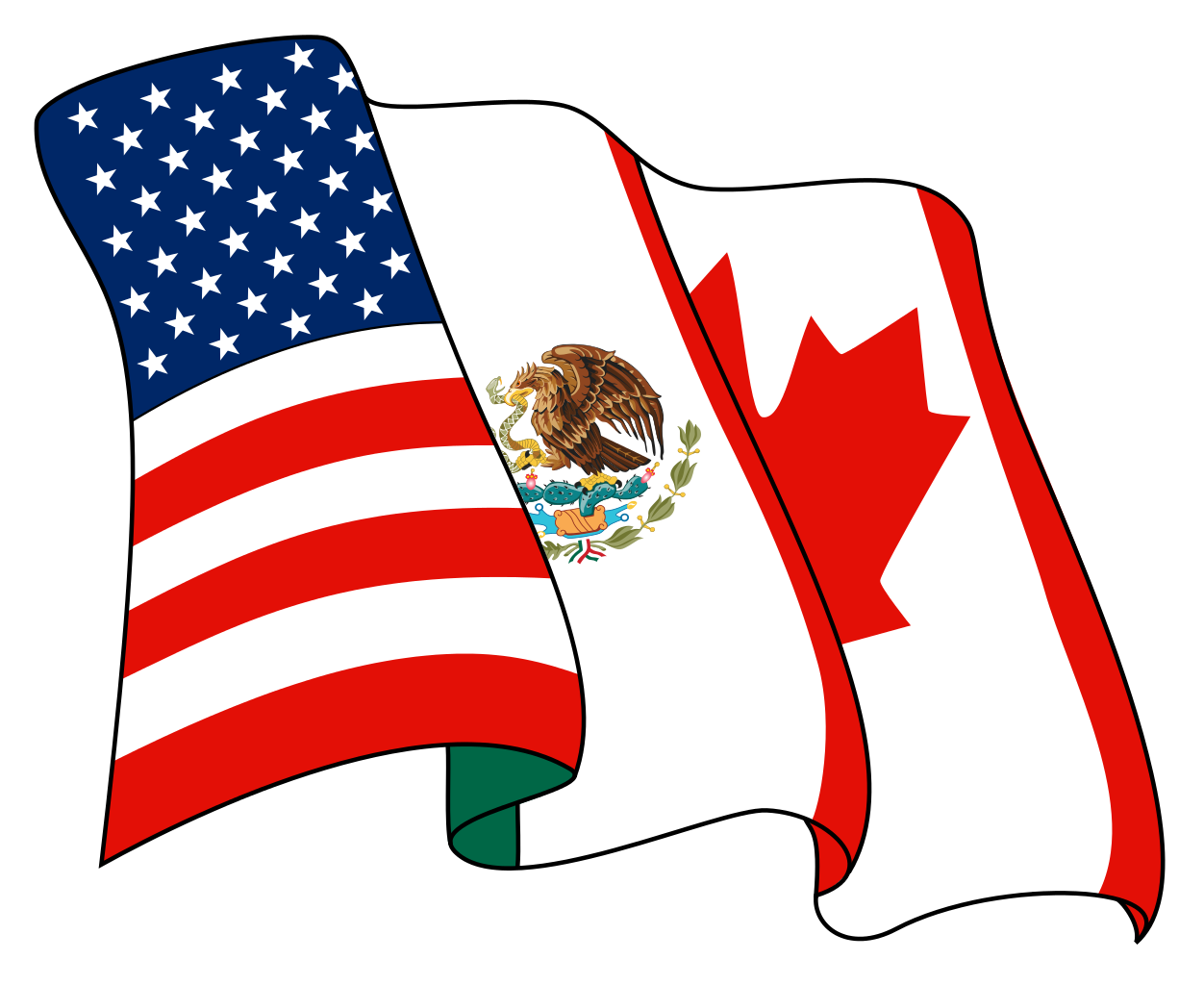 The first change affects the car industry. From 2020, 75% of the components of any vehicle crossing between the USA and Canada or Mexico must be made within one or more of the three countries to qualify for tariff-free treatment. The aim is to boost production within the region. But the main change here is merely an increase in the proportion from the current 62.5%.
The first change affects the car industry. From 2020, 75% of the components of any vehicle crossing between the USA and Canada or Mexico must be made within one or more of the three countries to qualify for tariff-free treatment. The aim is to boost production within the region. But the main change here is merely an increase in the proportion from the current 62.5%.
A more significant change affecting the car industry concerns wages. Between 40% and 45% of a vehicle’s components must be made by workers earning at least US$16 per hour. This is some three times more than the average wage currently earned by Mexican car workers. Although it will benefit such workers, it will reduce Mexico’s competitive advantage and could hence lead to some diversion of production away from Mexico. Also, it could push up the price of cars.
The agreement has also strengthened various standards inadequately covered in NAFTA. According to The Conversation article:
The new agreement includes stronger protections for patents and trademarks in areas such as biotech, financial services and domain names – all of which have advanced considerably over the past quarter century. It also contains new provisions governing the expansion of digital trade and investment in innovative products and services.
Separately, negotiators agreed to update labor and environmental standards, which were not central to the 1994 accord and are now typical in modern trade agreements. Examples include enforcing a minimum wage for autoworkers, stricter environmental standards for Mexican trucks and lots of new rules on fishing to protect marine life.
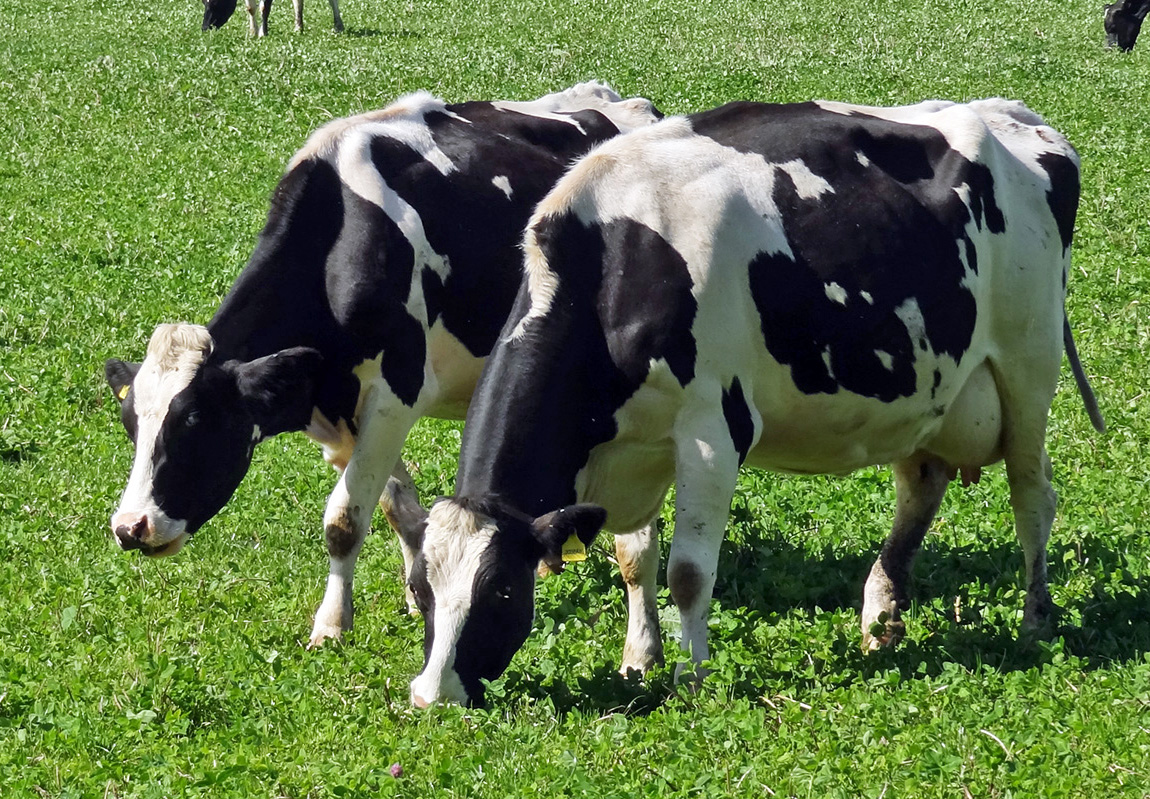 Another area where the USMCA agreement has made changes concerns trade in dairy products. This particularly affects Canada, which has agreed to allow more US dairy products tariff-free into Canada (see the CNN article at the end of the list of articles below). New higher quotas will give US dairy farmers access to 3.6% of Canada’s dairy market. They will still pay tariffs on dairy exports to Canada that exceed the quotas, ranging from 200% to 300%.
Another area where the USMCA agreement has made changes concerns trade in dairy products. This particularly affects Canada, which has agreed to allow more US dairy products tariff-free into Canada (see the CNN article at the end of the list of articles below). New higher quotas will give US dairy farmers access to 3.6% of Canada’s dairy market. They will still pay tariffs on dairy exports to Canada that exceed the quotas, ranging from 200% to 300%.
The other significant change for consumers in Mexico and Canada is a rise in the value of duty-free imports they can bring in from the USA, including online transactions. As the first BBC article listed below states:
The new agreement raises duty-free shopping limits to $100 to enter Mexico and C$150 ($115) to enter Canada without facing import duties – well above the $50 previously allowed in Mexico and C$20 permitted by Canada. That’s good news for online shoppers in Mexico and Canada – as well as shipping firms and e-commerce companies, especially giants like Amazon.
Despite these changes, USMCA is very similar to NAFTA. It is still a preferential trade deal between the three countries, but certainly not a completely free trade deal – but nor was NAFTA.
And for the time being, US tariffs on Mexican and Canadian steel and aluminium imports remain in place. Perhaps, with the conclusion of the USMCA agreement, the Trump administration will now, as promised, consider lifting these tariffs.
Video
Articles
- USMCA, the new trade deal between the US, Canada, and Mexico, explained
Vox, Jen Kirby (2/10/18)
- USMCA: What Donald Trump’s Nafta replacement trade deal means and how it will work
Independent, Mythili Sampathkumar (2/10/18)
- USMCA trade deal: Who gets what from ‘new Nafta’?
BBC News, Jessica Murphy & Natalie Sherman (1/10/18)
- Can Trump really cut the US trade deficit?
BBC News, Andrew Walker (2/10/18)
- How is ‘new NAFTA’ different? A trade expert explains
The Conversation, Amanda M. Countryman (2/10/18)
- Was NAFTA ‘worst trade deal ever’? Few agree
PolitiFact, Jon Greenberg (29/9/18)
- NAFTA out, USMCA in: What’s in the Canada, Mexico, US trade deal?
Aljazeera, Heather Gies (2/10/18)
- Mexico boosted by US-Canada agreement on revamped Nafta deal
Financial Times, Jude Webber (3/10/18)
- Nafta Is Dead. Long Live Nafta.
Bloomberg (2/10/18)
- Trump Clears Deck for China Trade War With New Nafta Deal
Bloomberg, Rich Miller, Andrew Mayeda and Jenny Leonard (2/10/18)
- Fact check: Is Trump right that the new trade deal is “biggest” ever?
CBS News (2/10/18)
- Commentary: What Trump’s new trade pact signals about China
Reuters, Andres Martinez (4/10/18)
- Canada opened its dairy market. But by how much?
CNN, Katie Lobosco (2/10/18)
Questions
- What have been the chief gains and losses for the USA from USMCA?
- What have been the chief gains and losses for Mexico from USMCA?
- What have been the chief gains and losses for Canada from USMCA?
- What are the economic gains from free trade?
- Why might a group of countries prefer a preferential trade deal with various restrictions on trade rather than a completely free trade deal between them?
- Distinguish between trade creation and trade diversion.
- In what areas, if any, might USMCA result in trade diversion?
- If the imposition of tariffs results in a net loss from a decline in trade, why might it be in the interests of a country such as the USA to impose tariffs?
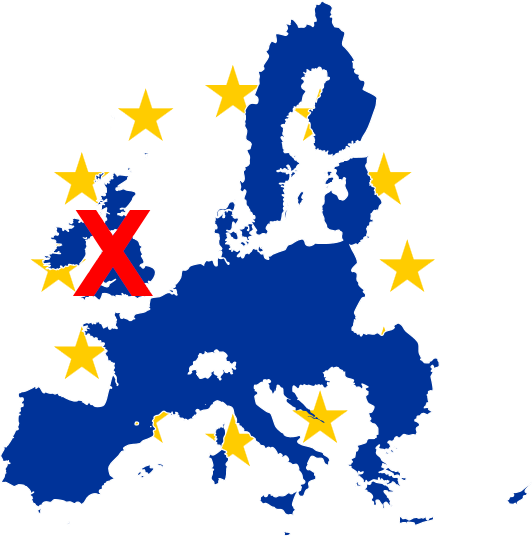 With the Conservatives having lost their majority in Parliament in the recent UK election, there is renewed discussion of the form that Brexit might take. EU states are members of the single market and the customs union. A ‘hard Brexit’ involves leaving both and this was the government’s stance prior to the election. But there is now talk of a softer Brexit, which might mean retaining membership of the single market and/or customs union.
With the Conservatives having lost their majority in Parliament in the recent UK election, there is renewed discussion of the form that Brexit might take. EU states are members of the single market and the customs union. A ‘hard Brexit’ involves leaving both and this was the government’s stance prior to the election. But there is now talk of a softer Brexit, which might mean retaining membership of the single market and/or customs union.
The single market
Belonging to the single market means accepting the free movement of goods, services, capital and labour. It also involves tariff-free trade within the single market and adopting a common set of rules and regulations over trade, product standards, safety, packaging, etc., with disputes settled by the European Court of Justice. Membership of the single market involves paying budgetary contributions. Norway and Iceland are members of the single market.
The single market brings huge benefits from free trade with no administrative barriers from customs checks and paperwork. But it would probably prove impossible to negotiate remaining in the single market with an opt out on free movement of labour. Controlling immigration from EU countries was a key part of the Leave campaign.
The customs union
This involves all EU countries adopting the same tariffs (customs duties) on imports from outside the EU. These tariffs are negotiated by the European Commission with non-EU countries 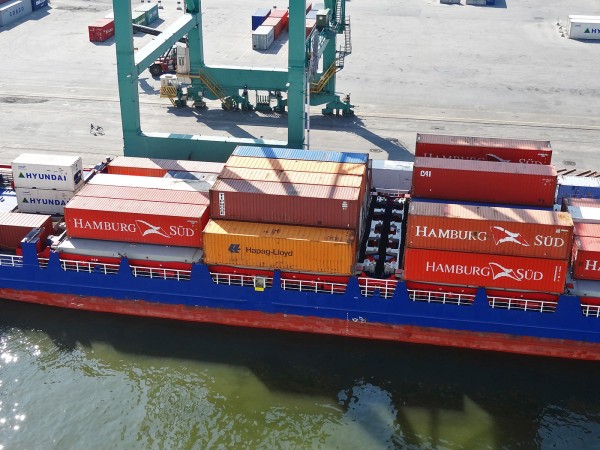 on a country-by-country basis. Goods imported from outside the EU are charged tariffs in the country of import and can then be sold freely around the EU with no further tariffs.
on a country-by-country basis. Goods imported from outside the EU are charged tariffs in the country of import and can then be sold freely around the EU with no further tariffs.
Remaining a member of the customs union would allow the UK to continue trading freely in the EU, subject to meeting various non-tariff regulations. It would also allow free ‘borderless’ trade between Northern Ireland and the Republic of Ireland. However, being a member of the customs union would prevent the UK from negotiating separate trade deals with non-EU countries. The ability to negotiate such deals has been argued to be one of the main benefits of leaving the EU.
Free(r) trade area
The UK could negotiate a trade deal with the EU. But it is highly unlikely that such a deal could be in place by March 2019, the date when the UK is scheduled to leave the EU. At that point, trade barriers would be imposed, including between the two parts of the island of Ireland. Such deals are very complex, especially in the area of services, which are the largest category of UK exports. Negotiating tariff-free or reduced-tariff trade is only a small part of the problem; the biggest part involves negotiating product standards, regulations and other non-tariff barriers.
All the above options thus involve serious problems and the government will be pushed from various sides, not least within the Conservative Party, for different degrees of ‘softness’ or ‘hardness’ of Brexit. What is more, the pressure from business for free trade with the EU is likely to grow. Brexit may mean Brexit, but just what form it will take is very unclear.
Articles
Free trade area, single market, customs union – what’s the difference? BBC News, Jonty Bloom (12/6/17)
Brexit: What are the options? BBC News (12/6/17)
After the election, the real test: Brexi The Economist (8/6/17)
May’s Ministers Plot Softer Brexit to Keep UK in Single Market Bloomberg, Tim Ross, Alex Morales and Svenja O’Donnell (11/6/17)
UK’s Hung Parliament Raises Business Hopes for a Softer Brexit Bloomberg, Stephanie Baker and James Paton (12/6/17)
Do not exaggerate the effect the election will have on Brexit Financial Times, Wolfgang Münchau (11/6/17)
What is soft Brexit? How could it work as UK negotiates leaving the EU? Independent, May Bulman (12/6/17)
Brexit-lite back on the table as Britain rethinks its options after election The Guardian, Dan Roberts (11/6/17)
Review plan to quit EU Customs Union, urges FTA FoodManufacture.co.uk, James Ridler (12/6/17)
Freight leaders urge government to review decision to leave EU customs union RTM (12/6/17)
Paper
Making Brexit work for British Business: Key Execution Priorities M-RCBG Associate Working Paper No. 77, Harvard Kennedy School, Peter Sands, Ed Balls, Sebastian Leape and Nyasha Weinberg (June 2017)
Questions
- Explain the trading agreement between Norway and the EU.
- How does the Norwegian arrangement with the EU differ from the Turkish one?
- What are meant by the terms ‘hard Brexit’ and ‘soft Brexit’?
- How does a customs union differ from a free trade area?
- Is it possible to have (a) a customs union without a single market; (b) a single market without a customs union?
- To what extent is it in the EU’s interests to negotiate a deal with the UK which lets it maintain access to the customs union without having free movement of labour?
- The EU insists that talks about future trading arrangements between the UK and the EU can take place only after sufficient progress has been made on the terms of the ‘divorce’. What elements are included in the divorce terms?
- If agreement is not reached by 29 March 2019, what happens and what would be the consequences?
- Will a hung parliament, or at least a government supported by the DUP on a confidence and supply basis, make it more or less likely that there will be a hard Brexit?
- For what reasons may the EU favour (a) a hard Brexit; (b) a soft Brexit?
 Theresa May has said that the UK will quit the EU single market and seek to negotiate new trade deals, both with the EU and with other countries. As she said, “What I am proposing cannot mean membership of the single market.” It would also mean leaving the customs union, which sets common external tariffs for goods imported into the EU.
Theresa May has said that the UK will quit the EU single market and seek to negotiate new trade deals, both with the EU and with other countries. As she said, “What I am proposing cannot mean membership of the single market.” It would also mean leaving the customs union, which sets common external tariffs for goods imported into the EU.
The single market guarantees free movement of goods, services, labour and capital between EU members. There are no internal tariffs and common rules and regulations concerning products, production and trade. By leaving the single market, the UK will be able to restrict immigration from EU countries, as it is currently allowed to do from non-EU countries.
A customs union is a free trade area with common external tariffs and uniform methods of handling imports. There are also no, or only minimal, checks and other bureaucracies at borders between members. The EU customs union means that individual EU countries are not permitted to do separate trade deals with non-EU countries.
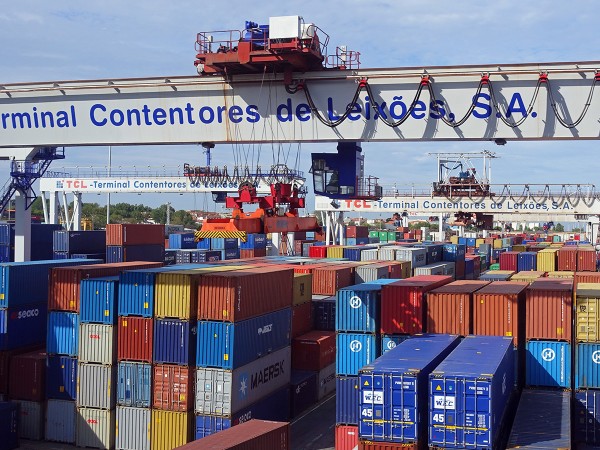 Once the UK has left the EU, probably in around two years’ time, it will then be able to have different trade arrangements from the EU with countries outside the EU. Leaving the customs union would mean that the UK would face the EU’s common external tariff or around 5% on most goods, and 10% on cars.
Once the UK has left the EU, probably in around two years’ time, it will then be able to have different trade arrangements from the EU with countries outside the EU. Leaving the customs union would mean that the UK would face the EU’s common external tariff or around 5% on most goods, and 10% on cars.
Leaving the EU single market and customs union has been dubbed ‘hard Brexit’. Most businesses and many politicians had hoped that elements of the single market could be retained, such as tariff-free trade between the UK and the EU and free movement of capital. However, by leaving the single market, access to it will depend on the outcome of negotiations.
Negotiations will take place once Article 50 – the formal notice of leaving – has been invoked. The government has said that it will do this by the end of March this year. Then, under EU legislation, there will be up to two years of negotiations, at which point the UK will leave the EU.
The articles look at the nature of the EU single market and customs union and at the implications for the UK of leaving them.
Articles
Britain to leave EU market as May sets ‘hard Brexit’ course Reuters, Kylie MacLellan and William James (17/1/17)
Brexit: UK to leave single market, says Theresa May BBC News (17/1/17)
How Does U.K. Want to Trade With EU Post-Brexit?: QuickTake Q&A Bloomberg, Simon Kennedy (17/1/17)
Brexit at-a-glance: What we learned from Theresa May BBC News, Tom Moseley (17/1/17)
Theresa May unveils plan to quit EU single market under Brexit Financial Times, Henry Mance (17/1/17)
Doing Brexit the hard way The Economist (21/1/17)
Theresa May confirms it’ll be a hard Brexit – here’s what that means for trade The Conversation, Billy Melo Araujo (17/1/17)
How to read Theresa May’s Brexit speech The Conversation, Paul James Cardwell (17/1/17)
Theresa May’s hard Brexit hinges on a dated vision of global trade The Conversation, Martin Smith (17/1/17)
Brexit: What is the EU customs union and why should people care that the UK is leaving it? Independent, Ben Chapman (17/1/17)
Questions
- Explain the difference between a free-trade area, a customs union, a common market and a single market.
- What arrangement does Norway have with the EU?
- How would the UK’s future relationship with the EU differ from Norway’s?
- Distinguish between trade creation and trade diversion from joining a customs union. Who loses from trade diversion?
- Will leaving the EU mean that trade which was diverted can be reversed?
- What will determine the net benefits from new trade arrangements compared with the current situation of membership of the EU?
- What are the possible implications of hard Brexit for (a) inward investment and (b) companies currently in the UK of relocating to other parts of the EU? Why is the magnitude of such effects extremely hard to predict?
- Explain what is meant by ‘passporting rights’ for financial services firms. Why are they unlikely still to have such rights after Brexit?
- Discuss the argument put forward in The Conversation article that ‘Theresa May’s hard Brexit hinges on a dated vision of global trade’.
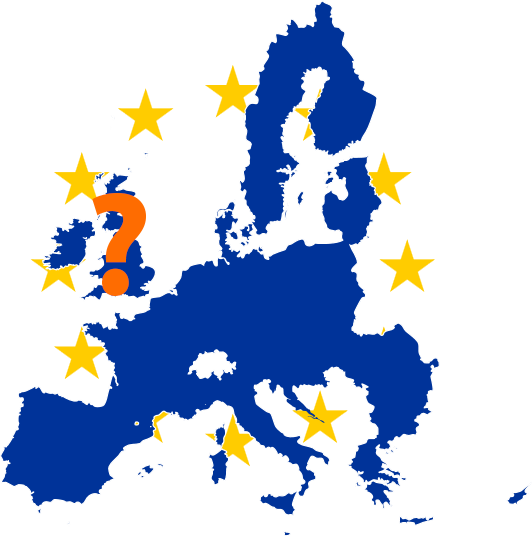 Many of the arguments used by both sides in the referendum debate centre on whether there will be a net economic gain from either remaining in or leaving the EU. This involves forecasting.
Many of the arguments used by both sides in the referendum debate centre on whether there will be a net economic gain from either remaining in or leaving the EU. This involves forecasting.
Forecasting the economic impact of the decision, however, is difficult, especially in the case of a leave vote, which would involve substantial change and uncertainty.
First, the effects of either remaining or leaving may be very different in the long run from the short run, and long-run forecasts are highly unreliable, as the economy is likely to be affected by so many unpredictable events – few people, for example, predicted the financial crisis of 2007–8.
Second, the effects of leaving depend on the nature of any future trading relationships with the EU. Various possibilities have been suggested, including ‘the Norwegian model’, where Britain leaves the EU, but joins the European Economic Area, giving access to the single market, but removing regulation in some key areas, such as fisheries and home affairs. 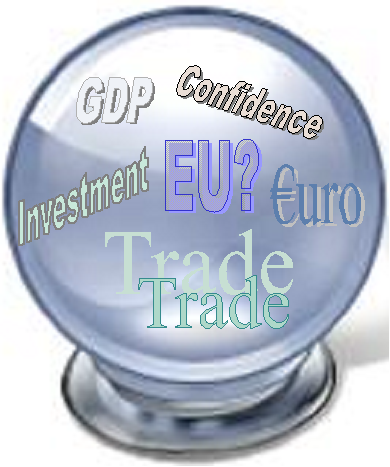 Another possibility is ‘the Swiss model’, where the UK would negotiate trade deals on an individual basis. Another would be ‘the Turkish model’ where the UK forms a customs union with the EU. At the extreme, the UK could make a complete break from the EU and simply use its membership of the WTO to make trade agreements.
Another possibility is ‘the Swiss model’, where the UK would negotiate trade deals on an individual basis. Another would be ‘the Turkish model’ where the UK forms a customs union with the EU. At the extreme, the UK could make a complete break from the EU and simply use its membership of the WTO to make trade agreements.
Nevertheless, despite the uncertainty, economists have ventured to predict the effects of remaining or leaving. These are not precise predictions for the reasons given above. Rather they are based on likely assumptions.
In a poll of 100 economists for the Financial Times, ‘almost three-quarters thought leaving the EU would damage the country’s medium-term outlook, nine times more than the 8 per cent who thought the country would benefit from leaving’. Most fear damage to financial markets in the UK and to inward foreign direct investment.
Despite the barrage of pessimistic forecasts by economists about a British exit, there is a group of eight economists in favour of Brexit. They claim that leaving the EU would lead to a stronger economy, with higher GDP, a faster growth in real wages, lower unemployment and a smaller gap between imports and exports. The main argument they use to support their claims is that the UK would be more able to pursue trade creation freed from various EU rules and regulations.
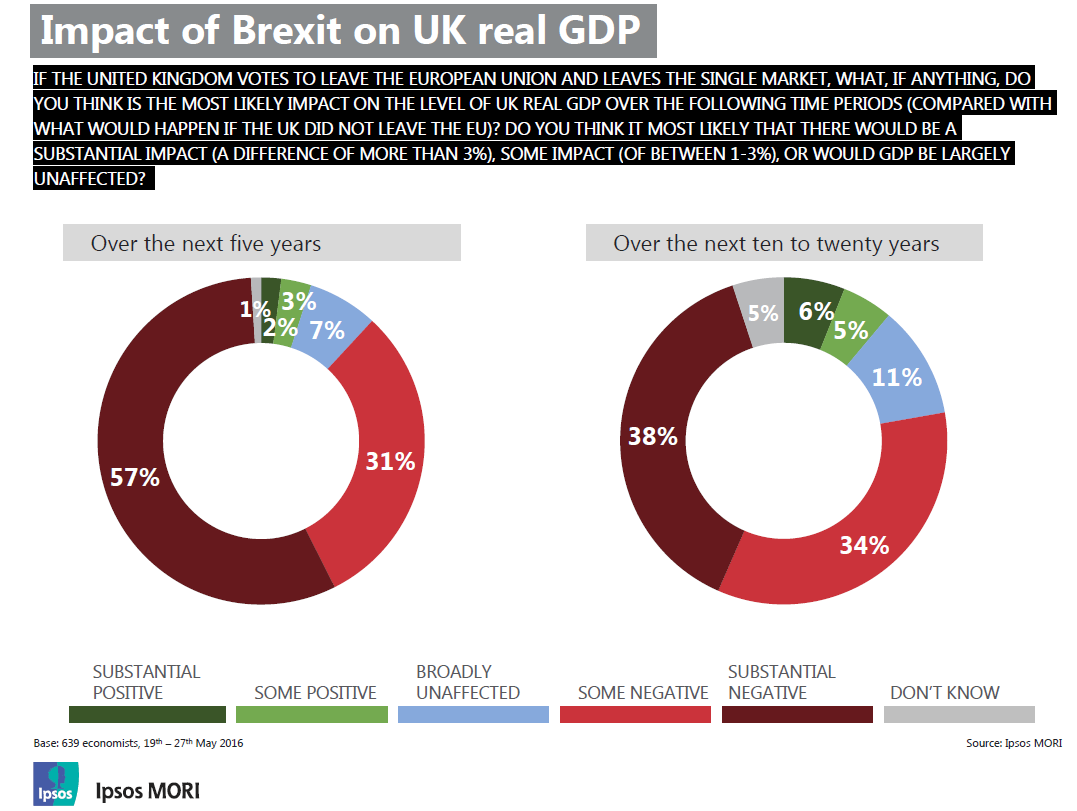 Then, less than four weeks before the vote, a poll of economists who are members of the Royal Economic Society and the Society of Business Economists came out strongly in favour of continued membership of the EU. Of the 639 respondents, 72 per cent thought that the most likely impact of Brexit on UK real GDP would be negative over the next 10 to 20 years; and 88 per cent thought the impact on GDP would be negative in the next five years (see chart: click to enlarge).
Then, less than four weeks before the vote, a poll of economists who are members of the Royal Economic Society and the Society of Business Economists came out strongly in favour of continued membership of the EU. Of the 639 respondents, 72 per cent thought that the most likely impact of Brexit on UK real GDP would be negative over the next 10 to 20 years; and 88 per cent thought the impact on GDP would be negative in the next five years (see chart: click to enlarge).
Of those stating that a negative impact on GDP in the next 5 years would be most likely, a majority cited loss of access to the single market (67%) and increased uncertainty leading to reduced investment (66%).
The views of the majority of economists accord with those of various organisations. Domestic ones, such as the Bank of England, the Treasury (see the blog Brexit costs), the Institute for Fiscal Studies and the National Institute for Economic and Social Research (NIESR) all warn that Brexit would be likely to result in lower growth – possibly a recession – increased unemployment, a fall in the exchange rate and higher prices and that greater economic uncertainty would damage investment.
International organisations, such as the OECD, the IMF and the WTO, also argue that leaving the EU would create great uncertainty over future trade relations and access to the Single Market and would reduce inward foreign direct investment and the flow of skills.
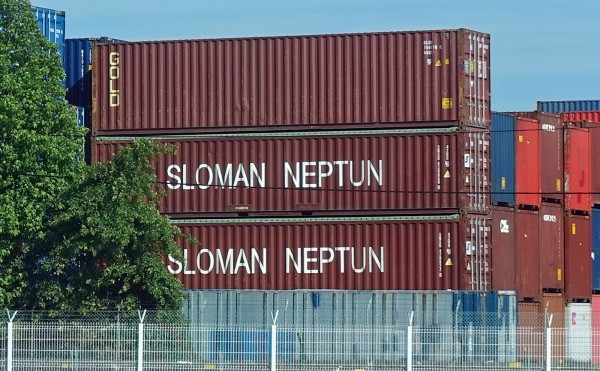 But the forecasts of all these organisations depend on their assumptions about trade relations and that, in the event of the UK leaving the EU, would depend on the outcome of trade negotiations. The Leave campaign argues that other countries would want to trade with the UK and that therefore leaving would not damage trade. The Remain campaign argues that the EU would not wish to be generous to the UK for fear of encouraging other countries to leave the EU and that, anyway, the process of decoupling from the EU and negotiating new trade deals would take many years and, in the meantime, the uncertainty would be damaging to investment and growth.
But the forecasts of all these organisations depend on their assumptions about trade relations and that, in the event of the UK leaving the EU, would depend on the outcome of trade negotiations. The Leave campaign argues that other countries would want to trade with the UK and that therefore leaving would not damage trade. The Remain campaign argues that the EU would not wish to be generous to the UK for fear of encouraging other countries to leave the EU and that, anyway, the process of decoupling from the EU and negotiating new trade deals would take many years and, in the meantime, the uncertainty would be damaging to investment and growth.
The articles linked below looks at the economic arguments about Brexit and reflect the range of views of economists. Several are from ‘The Conversation’ as these are by academic economists. Although some economists are in favour of Brexit, the vast majority support the Remain side in the debate.
Articles
EU referendum: Pros and cons of Britain voting to leave Europe The Week (4/5/16)
The fatal contradictions in the Remain and Leave camps The Economist (3/6/16)
Four reasons a post-Brexit UK can’t copy Norway or Switzerland The Telegraph, Andrew Sentance (10/6/16)
What will Brexit do to UK trade? Independent, Ben Chu (2/6/16)
Leavers may not like economists but we are right about Brexit Institute for Fiscal Studies, Paul Johnson (9/6/15)
Why Brexit supporters should take an EU-turn – just like I did The Conversation, Wilfred Dolfsma (8/6/16)
The economic case for Brexit The Conversation, Philip B. Whyman (28/4/16)
Fact Check: do the Treasury’s Brexit numbers add up? The Conversation, Nauro Campos (20/4/16)
Which Brexit forecast should you trust the most? An economist explains The Conversation, Nauro Campos (25/4/16)
Why is the academic consensus on the cost of Brexit being ignored? The Conversation, Simon Wren-Lewis (17/5/16)
How Brexit would reduce foreign investment in the UK – and why that matters The Conversation, John Van Reenen (15/4/16)
The consensus on modelling Brexit NIESR, Jack Meaning, Oriol Carreras, Simon Kirby and Rebecca Piggott (23/5/16)
Reports, Press Conferences, etc.
Economists’ forecasts: Brexit would damage growth Financial Times, Chris Giles and Emily Cadman (3/1/16)
The Economy After Brexit, Economists for Brexit
Economists’ Views on Brexit Ipsos MORI (28/5/16)
Inflation Report Bank of England (May 2016)
EU referendum: HM Treasury analysis key facts HM Treasury (18/4/16)
Brexit and the UK’s public finances Institute for Fiscal Studies, Carl Emmerson , Paul Johnson , Ian Mitchell and David Phillips (25/5/16)
The Long and the Short of it: What price UK Exit from the EU? NIESR, Oriol Carreras, Monique Ebell, Simon Kirby, Jack Meaning, Rebecca Piggott and James Warren (12/5/16)
The Economic Consequences of Brexit: A Taxing Decision OECD (27/4/16)
Transcript of the Press Conference on the Release of the April 2016 World Economic Outlook IMF (12/4/16)
Macroeconomic implications of the United Kingdom leaving the Euroepan Union IMF Country Report 16/169 (1/6/16)
WTO warns on tortuous Brexit trade talks Financial Times, Shawn Donnan (25/5/16)
Questions
- Summarise the main economic arguments of the Remain side.
- What assumptions are made by the Remain side about Brexit?
- Summarise the main economic arguments of the Leave side.
- What assumptions are made by the Leave side about Brexit?
- Assess the realism of the assumptions of the two sides.
- If the UK exited the EU, would it be possible to continue gaining the benefits of the single market while restricting the free movement of labour?
- Would it be beneficial to go for a ‘free trade’ option of abolishing all import tariffs if the UK left the EU? Would it mean that UK exports would face no tariffs from other countries?
- If forecasting is unreliable, does this mean that nothing can be said about the costs and benefits of Brexit? Explain.
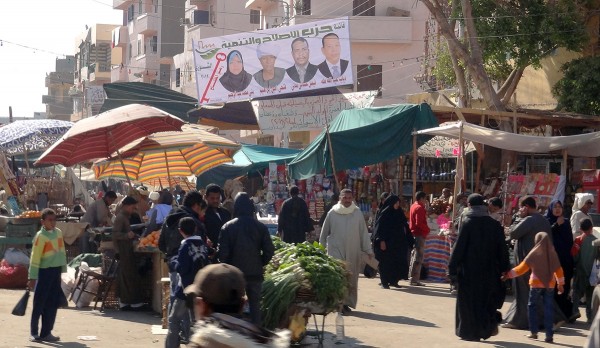 A deal has just been signed between 26 African nations to form a new free trade area, the Tripartite Free Trade Area (TFTA). The countries have a population of 625 million (56% of Africa’s total) and a GDP of $1.6 trillion (63% of Africa’s total). The deal effectively combines three existing free trade areas: the Common Market for Eastern and Southern Africa, the Southern African Development Community and the East African Community.
A deal has just been signed between 26 African nations to form a new free trade area, the Tripartite Free Trade Area (TFTA). The countries have a population of 625 million (56% of Africa’s total) and a GDP of $1.6 trillion (63% of Africa’s total). The deal effectively combines three existing free trade areas: the Common Market for Eastern and Southern Africa, the Southern African Development Community and the East African Community.
Although the deal has been signed by the nations’ leaders, it still needs parliamentary approval from each of the countries. It is hoped that this will be achieved by 2017. If it is, it will mark a major step forward in encouraging intra-African trade.
The deal will involve the removal of trade barriers on most goods and lead to a reduction in overall tariffs by more than 50%. The expectation of the leaders is that this will generate $1 trillion worth of economic activity across the 26 countries through a process of trade creation, investment, increased competition and the encouragement of infrastructure development.  But given the current poor state of infrastructure and the lack of manufacturing capacity in many of the countries, the agreement will also encourage co-operation to promote co-ordinated industrial and infrastructure development.
But given the current poor state of infrastructure and the lack of manufacturing capacity in many of the countries, the agreement will also encourage co-operation to promote co-ordinated industrial and infrastructure development.
Up to now, the development of intra-African trade has been relatively slow because of poor road and rail networks and a high average protection rate – 8.7% on exports to other African countries compared with 2.5% on exports to non-African countries. As a result, intra-African trade currently accounts for just 12% of total African trade. It is hoped that the development of TFTA will result in this rising to over 30%.
Much of the gains will come from economies of scale. As Kenyan academic Calestous Juma says:
“By having larger markets, it signals the possibility of being able to manufacture products at a scale that is cost-effective. For example, where you need large-scale investments like $200m to create a pharmaceutical factory, you couldn’t do that if you were only selling the products in one country.”
The question is whether the agreement signed on the 10 June will lead to the member countries fully taking advantage of the opportunities for trade creation. Agreeing on a deal is one thing; having genuinely free trade and investing in infrastructure and new efficient industries is another.
Videos and audio
 African leaders ink trade deal Deutsche Welle (11/6/15)
African leaders ink trade deal Deutsche Welle (11/6/15)
 African leaders sign pact to create ‘Cape to Cairo’ free trade bloc euronews (10/6/15)
African leaders sign pact to create ‘Cape to Cairo’ free trade bloc euronews (10/6/15)
 Africa Free Trade Analysis BBC Africa, Calestous Juma (9/6/15)
Africa Free Trade Analysis BBC Africa, Calestous Juma (9/6/15)
Articles
African Leaders To Sign Free Trade Agreement To Create Common Market International Business Times, Aditya Tejas (10.6.15)
EAC, COMESA and SADC Blocs Ink ‘Historic’ Trade Deal allAfrica, James Karuhanga (11/6/15)
Tripartite Free Trade Area an Opportunity Not a Threat allAfrica, Sindiso Ngwenya (9/6/15)
Africa a step closer to free trade area Business Report (South Africa), Rob Davies (11/6/15)
The Cape to Cairo trade ‘super bloc’ is here; 15 surprising – and shocking – facts on trade within Africa Mail & Guardian (Kenya), Christine Mungai (8/6/15)
The tripartite free trade area agreement in Africa is bound to disappoint Quartz Africa, Hilary Matfess (10/6/15)
Africa creates TFTA – Cape to Cairo free-trade zone BBC News Africa (10/6/15)
Will the Cape to Cairo free-trade zone work? BBC News Africa, Lerato Mbele (10/6/15)
African free trade still some way off BBC News, Matthew Davies (10/6/15)
Zambia not to benefit from Africa’s TFTA Medafrica, Geraldine Boechat (10/6/15)
Questions
- Distinguish between a free trade area, a customs union and a common market.
- What does the law of comparative advantage imply about the gains from forming a free trade area?
- Distinguish between trade creation and trade diversion.
- Why is it likely that there will be considerable trade creation from TFTA? Would there be any trade diversion?
- Why are small countries with a relatively low level of economic development likely to experience more trade creation than larger, richer ones?
- What barriers might remain in trade between the TFTA countries?
- Why might smaller, less developed members of TFTA be worried about the removal of trade barriers?
- Why might concentrating on developing local capacity, rather than just lowering tariffs, be a more effective way of developing intra-African trade
- What ‘informal’ barriers to trade exist in many African countries?
- Why is it that ‘Ordinary Africans are most probably not holding their breath’ about the gains from TFTA?
 An agreement in principle was reached on September 30 between the USA, Canada and Mexico over a new trade deal to replace the North American Free Trade Agreement (NAFTA). President Trump had described NAFTA as ‘the worst trade deal maybe ever signed anywhere, but certainly ever signed in this country.’ The new deal, named the United States-Mexico-Canada Agreement, or USMCA, is the result of 14 months of negotiations, which have often been fractious. A provisional bilateral agreement was made between the USA and Mexico in August. At the same time, President Trump threatened a trade war with Canada if it did not reach a trade agreement with the USA (and Mexico). The new USMCA must be ratified by lawmakers in all three countries before it can come into force. This could take a few months.
An agreement in principle was reached on September 30 between the USA, Canada and Mexico over a new trade deal to replace the North American Free Trade Agreement (NAFTA). President Trump had described NAFTA as ‘the worst trade deal maybe ever signed anywhere, but certainly ever signed in this country.’ The new deal, named the United States-Mexico-Canada Agreement, or USMCA, is the result of 14 months of negotiations, which have often been fractious. A provisional bilateral agreement was made between the USA and Mexico in August. At the same time, President Trump threatened a trade war with Canada if it did not reach a trade agreement with the USA (and Mexico). The new USMCA must be ratified by lawmakers in all three countries before it can come into force. This could take a few months. The first change affects the car industry. From 2020, 75% of the components of any vehicle crossing between the USA and Canada or Mexico must be made within one or more of the three countries to qualify for tariff-free treatment. The aim is to boost production within the region. But the main change here is merely an increase in the proportion from the current 62.5%.
The first change affects the car industry. From 2020, 75% of the components of any vehicle crossing between the USA and Canada or Mexico must be made within one or more of the three countries to qualify for tariff-free treatment. The aim is to boost production within the region. But the main change here is merely an increase in the proportion from the current 62.5%. Another area where the USMCA agreement has made changes concerns trade in dairy products. This particularly affects Canada, which has agreed to allow more US dairy products tariff-free into Canada (see the CNN article at the end of the list of articles below). New higher quotas will give US dairy farmers access to 3.6% of Canada’s dairy market. They will still pay tariffs on dairy exports to Canada that exceed the quotas, ranging from 200% to 300%.
Another area where the USMCA agreement has made changes concerns trade in dairy products. This particularly affects Canada, which has agreed to allow more US dairy products tariff-free into Canada (see the CNN article at the end of the list of articles below). New higher quotas will give US dairy farmers access to 3.6% of Canada’s dairy market. They will still pay tariffs on dairy exports to Canada that exceed the quotas, ranging from 200% to 300%. New NAFTA deal
New NAFTA deal








